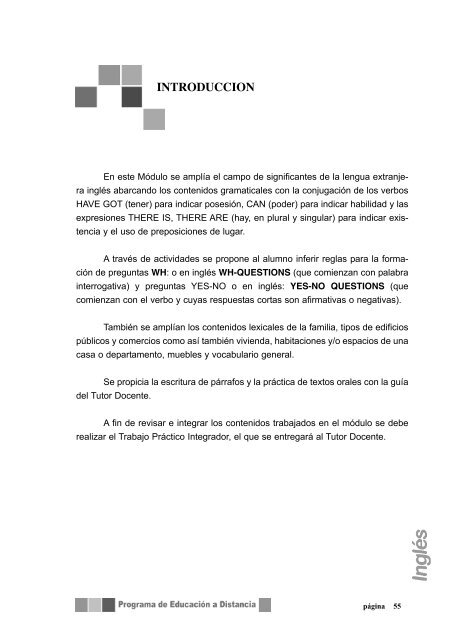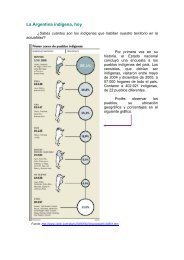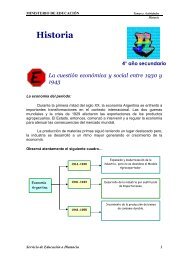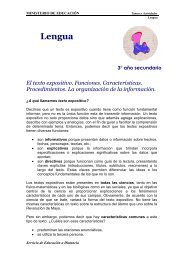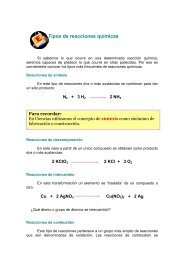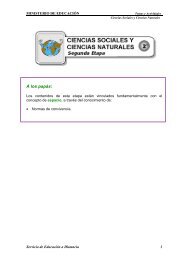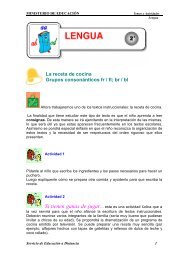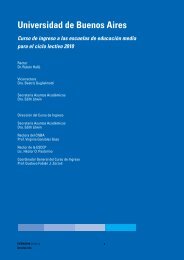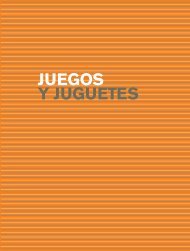Descargar el PDF - Aprender en casa
Descargar el PDF - Aprender en casa
Descargar el PDF - Aprender en casa
You also want an ePaper? Increase the reach of your titles
YUMPU automatically turns print PDFs into web optimized ePapers that Google loves.
I HAVE GOT TWO CHILDRENTENGO DOS HIJOSMy name is Joseph. I´m married and my wife´s name is Luisa. I have got two childr<strong>en</strong>,one son and a daughter. Their names are John and Rebecca. John is two,Rebecca is four.Actividad 1• Read the text about Joseph and his family and answer the questions.• Lea <strong>el</strong> texto acerca de Joseph y su familia y responda las preguntas.1- ¿Qué palabras le resultan conocidas <strong>en</strong> <strong>el</strong> texto? (No olvide leer <strong>el</strong>título).Confeccione una lista <strong>en</strong> la tabla a continuación y escriba su traducción.English wordsPalabras <strong>en</strong> inglésTranslationTraducciónpágina 57
2- Puede traducir la sigui<strong>en</strong>te oración? (Vu<strong>el</strong>va a leer <strong>el</strong> Módulo 2Actividad 56 y la reseña de Gramática).My wife´s name is Luisa:…………………………………….......................................................3- ¿Qué verbo/ s expresa/ n posesión <strong>en</strong> <strong>el</strong> texto?…………………………………………………………………………….4- ¿Cuál es la traducción?………………………………………………………………………....…WE HAVE GOT THREE CHILDRENTENEMOS TRES HIJOSI´m Roberta Smith. My husband´s nameis Peter. We have got three childr<strong>en</strong>. Theirnames are J<strong>en</strong>ny, Ron and Harry. Ron andHarry are twins and they are five years old.J<strong>en</strong>ny is four.Actividad 2• Read the text about Roberta Smith and complete her family tree.• Lea <strong>el</strong> texto acerca de Roberta Smith y complete su árbol familiar.página 58
ROBERTA SMITH´S FAMILY TREEEL ÁRBOL FAMILIAR DE ROBERTA SMITHMARCOS´S FAMILYLA FAMILIA DE MARCOSActividad 3• Read the following text about Marcos´s family. Look at the picture andwrite the names of the people in it.• Lea <strong>el</strong> sigui<strong>en</strong>te texto acerca de la familia de Marcos. Observe laimag<strong>en</strong> y escriba los nombres de las personas <strong>en</strong> <strong>el</strong>la.página 59
The man on the left is Marcos Sosa.He is from Lisbon in Portugal. He´sPortuguese. He´s a lawyer. He´sthirty-eight years old and he´smarried. The man on the right isMarcos´s brother. His name isSergio. He is thirty-six and he is an<strong>en</strong>gineer.Marcos has got three childr<strong>en</strong>, twodaughters and one son. His daughters´names are Rosa and Maria. Hisson´s name is Luciano. Rosa is fourte<strong>en</strong>and Maria is fifte<strong>en</strong>. Luciano isnine.Sergio has got two childr<strong>en</strong>. Joaoand Paolo. They are twins. They aretw<strong>el</strong>ve.Actividad 4• Complete the following s<strong>en</strong>t<strong>en</strong>ces with the words from the text inActividad 3.• Complete las sigui<strong>en</strong>tes oraciones con las palabras d<strong>el</strong> texto <strong>en</strong>Actividad 3.1- Marcos is Sergio´s ……………………….2- Marcos is Rosa, Maria and Luciano´s ………………………. .3- Rosa, Maria and Luciano are Marcos´s …………………….. .4- Sergio is Joao and Paolo´s ………………………. .5- Joao and Paolo are Sergio´s ………………………. .El texto de la Actividad 3 describe dos familias, de esta descripción surg<strong>en</strong>más par<strong>en</strong>tescos de los que ya hemos estudiado, por ejemplo tío, primo/a/s,sobrino/a. Observe <strong>en</strong> la tabla como éstos y algunos otros se nombran <strong>en</strong> inglés:página 60
Male and SingularMasculino y SingularUncle (tío)Nephew (sobrino)Cousin (primo)Grandson (nieto)Grandfather (abu<strong>el</strong>o)Female and SingularFem<strong>en</strong>ino y SingularAunt (tía)Niece (sobrina)Cousin (prima)Grand-daughter (nieta)Grandmother (abu<strong>el</strong>a)PluralPluralCousins (primos)Grandchildr<strong>en</strong> (nietos)Grandpar<strong>en</strong>ts (abu<strong>el</strong>os)GRAMMARGRAMÁTICAEl caso posesivo (possessive ´s) <strong>en</strong> inglés ya fue pres<strong>en</strong>tado <strong>en</strong> <strong>el</strong> MODU-LO 2, página 111 Sección GRAMMAR / GRAMÁTICA. El cuadro que usted leeráa continuación amplía la información y muestra la construcción INCORRECTA d<strong>el</strong>caso <strong>en</strong> la columna IZQUIERDA. ¿Porqué la consideramos INCORRECTA?, porquees la que resultaría de una TRADUCCIÓN LITERAL d<strong>el</strong> ESPAÑOL alINGLÉS. La columna DERECHA pres<strong>en</strong>ta la construcción CORRECTA <strong>en</strong>INGLÉSpágina 61
POSSESSIVE ´SCASO POSESIVO ´SINCORRECTASingular• the father of Lucy• the bicycle of Lucy• the daughter of Charles• the mother of Lucy and JasonCORRECTASingular• Lucy´s father (1) ver nota• Lucy´s bicycle• Charles´s daughter (2) ver nota• Lucy and Jason´s mother (3) vernotaPlural• the bedroom of my sisters• the books of the childr<strong>en</strong>Plural• my sisters´ bedroom (4) vernota• the childr<strong>en</strong>´s books (5) vernotaNOTA:(1) se agrega apóstrofo + s a la persona.(2) se agrega apóstrofo + s al nombre de la persona que termina <strong>en</strong> s.(3) se agrega apóstrofo + s al último nombre propio.(4) sólo se agrega apóstrofo, SIN s, porque <strong>el</strong> sustantivo que nombra alas personas es plural regular, es decir que lleva s final.(5) se agrega apóstrofo + s al sustantivo plural irregular, es decir <strong>el</strong> qu<strong>en</strong>o lleva s final.Actividad 5• Write the correct forms and match the phrases with the pictures.• Escriba las formas correctas y combine las frases con las imág<strong>en</strong>es.página 62
Example:• Peter / sister: Peter´s sister1- Chris / teacher: …………………………………………………………2- Ann / cousin:…………………………………………………………….3- Laura and John / house:……………………………………………….4- His par<strong>en</strong>ts / car:………………………………………………………..5- Jason / family:……………………………………………………………Además de revisar <strong>el</strong> vocabulario de MIEMBROS DE LA FAMILIA, ya estudiado<strong>en</strong> <strong>el</strong> MÓDULO 2, profundizar <strong>el</strong> CASO POSESIVO ´S, se pres<strong>en</strong>ta unverbo que expresa POSESIÓN: <strong>el</strong> verbo HAVE GOT, que se traduce comoTENER.Actividad 6• Vu<strong>el</strong>va a leer <strong>el</strong> primer texto cuyo título es “I HAVE GOT TWOCHILDREN” (YO TENGO DOS HIJOS o TENGO DOS HIJOS) subraye la oración,además d<strong>el</strong> título, que expresa posesión y transcríbala a continuación, bajo<strong>el</strong> título primer texto.página 63
• Lea nuevam<strong>en</strong>te <strong>el</strong> segundo texto que se pres<strong>en</strong>ta <strong>en</strong> este MÓDULO“WE HAVE GOT THREE CHILDREN” (NOSOTROS TENEMOS TRES HIJOS oTENEMOS TRES HIJOS, subraye la oración que expresa posesión y transcríbalabajo <strong>el</strong> título segundo texto.Primer texto:…………………………………………………………………………………Segundo texto:…………………………………………………………………………………• ¿Puede llegar a alguna conclusión?Conclusión:…………………………………………………………………………………• Vu<strong>el</strong>va a la ACTIVIDAD 3 y r<strong>el</strong>ea <strong>el</strong> texto “MARCOS´S FAMILY” (LAFAMILIA DE MARCOS), subraye las oraciones que expresan posesión.Transcríbalas a continuación bajo <strong>el</strong> título tercer texto.Tercer texto:……………………………………………………………………………………………………………………………………………………………………Actividad 7• Complete <strong>el</strong> sigui<strong>en</strong>te cuadro con los pronombres con los que puedeconjugar cada verbo.página 64
HAVE GOT……………………………………....…..……………………………………....…..…………………………………....……..…………………………………....……..HAS GOT………………………………………….……………………………………….....…………………………………...……..…………………………………...……..Actividad 8• Complete the s<strong>en</strong>t<strong>en</strong>ces with “have got” or “has got”.• Complete las oraciones con”have got” o “has got”.1- A car …………………..four whe<strong>el</strong>s.2- Atoms……………………..protons, neutrons and <strong>el</strong>ectrons.3- You………………………a beautiful smile.4- I……………………….a big house.5- We……………………..two daughters.Actividad 9• Complete the s<strong>en</strong>t<strong>en</strong>ces.• Complete las oraciones.1- He has got an apartm<strong>en</strong>t in Bu<strong>en</strong>os Aires.They………………………………………………….2- The woman has got a big family.They…………………………………………………..3- The boy has got a lot of fri<strong>en</strong>ds.They………………………………………………….4- The dog has got a short tail.They………………………………………………….página 65
GRAMMARGRAMÁTICAEstudie la conjugación d<strong>el</strong> verbo HAVE GOT (TENER) <strong>en</strong> su forma AFIR-MATIVA. En <strong>el</strong> cuadro se pres<strong>en</strong>tan la forma COMPLETA y la CONTRACCIÓN.Full FormForma CompletaContractionContracciónAffirmativeAffirmativeI have got a bicycle.You have got a radio.He has got a TV set.She has got a dog.It has got four legs.We have got a big family,You have got a new dress.They have got a small house.I´ve got a bicycle.You´ve got a radio.He´s got a TV set.She´s got a dog.It´s got four legs.We´ve got a big family,You´ve got a new dress.They´ve got a small house.página 66
Actividad 10• Fill in the blanks as in the examples.• Complete los espacios <strong>en</strong> blanco como <strong>en</strong> los ejemplos.Long Form (Forma Larga)Short Form or Contraction(Forma Corta o Contracción)Example: She has got a p<strong>en</strong>.1- I……………………a red dress.2- Jim………………..a bicycle.3- We………………..a big house.4- They………………black shoes.5- You………………..a bottle of milk.Example: She´s got a p<strong>en</strong>.1- I…………………...a red dress.2- Jim………………..a bicycle.3- We………………..a big house.4- They……………...black shoes.5- You……………….a bottle of milk.Actividad 11• Complete the following passage with HAVE GOT or HAS GOT.• Complete <strong>el</strong> sigui<strong>en</strong>te párrago con HAVE GOT o HAS GOT.Jonathan is tw<strong>el</strong>ve years old. He (1)…………………………….. a brother and twosisters. His brother is 20 years old andhis sisters are 18 and 21. They are atUniversity. They(2)……………………………………asmall house in the city. Jonathan andhis par<strong>en</strong>ts live on a farm. It is a bigfarm and Jonathan is very happythere.They (3)………………………..anice house and a lot of animals.página 67
LUCY´S E-MAILEL E-MAIL DE LUCY• Lucy has got a fri<strong>en</strong>d in Cambridge. His name is Keith Springs. Thisis Lucy´s mail to Keith.• Lucy ti<strong>en</strong>e un amigo <strong>en</strong> Cambridge. Su nombre es Keith Springs.Este es <strong>el</strong> mail de Lucy para Keith.To: keith@fri<strong>en</strong>ds.caFrom: lrichards@and.loSubject: My familyHi, KeithHow are you?Thanks for your e-mail.My family is big. Your question is “Haveyou got any brothers or sisters?”, theanswer is “Yes, I have! I have got a brother,but I hav<strong>en</strong>´t got any sisters. Mybrother´s name is Jason and he is 17.He´s a stud<strong>en</strong>t. He has got a beautifulgirlfri<strong>en</strong>d. Her name´s Mary and she´salso 17.My father´s name is Mathew. He´s 42and he´s a doctor. My mother´s name isLorna and she´s 40. She´s a teacher. We have got a dog and a cat. Our dog´sname is Rocky and our cat´s name is Misha.My father has got a brother, uncle Charles. He´s married, his wife´s name is Alice.Their daughter is my cousin, Rach<strong>el</strong>. She´s very funny. She´s a university stud<strong>en</strong>tand a singer. She hasn´t got any brothers or sisters.I have got a grandmother and a grandfather. My grandmother´s name is Dorothyand she´s 64. My grandfather´s name is Gl<strong>en</strong> and he´s 67. They are very nice.They have got a beautiful house in Alicante, in Spain.Write and t<strong>el</strong>l me about your family.Bye,Lucypágina 68
Actividad 12• Read Lucy´s e-mail again and complete her family tree.• Lea <strong>el</strong> e-mail de Lucy nuevam<strong>en</strong>te y complete su árbol familiar.…………………… = Dorothy RichardsMathew Richards = ………………….Charles Richards = ……………………….Lucy Richards Jason Richards ………………………….Actividad 13• Look at Lucy´s family tree and complete the s<strong>en</strong>t<strong>en</strong>ces b<strong>el</strong>ow.• Observe <strong>el</strong> árbol familiar de Lucy y complete las oraciones que estána continuación.Example:• Lucy Richards is Jason´s sister.1- Jason is Lucy´s …………………..2- Lorna Richards is Lucy´s ………………3- Mathew Richards is Lucy´s …………………4- Mathew and Lorna are Jason´s ……………………...5- Lucy and Jason are Mathew and Lorna´s ……………………6- Mathew is Lorna´s …………………………..7- Lorna is Mathew´s ………………….8- Jason is Mathew and Lorna´s …………………..9- Lucy is Mathew and Lorna´s ……………………10- Gl<strong>en</strong> Richards is Lucy´s …………………………página 69
11- Dorothy Richards is Lucy´s ………………………….12- Rach<strong>el</strong> Richards is Lucy´s ………………………….13- Charles Richards is Lucy´s …………………………14- Alice Richards is Lucy´s …………………………15- Lucy is Charles and Alice´s …………………........16- Jason is Charles and Alice´s …………………………17- Lucy, Jason and Rach<strong>el</strong> are Gl<strong>en</strong> and Dorothy´s ………………………Actividad 14• Read the e-mail again and circle the correct answer.• Lea <strong>el</strong> e-mail nuevam<strong>en</strong>te y <strong>en</strong>cierre <strong>en</strong> un círculo la respuestacorrecta.1- Has Lucy got a big family?a- Yes, she has. b- No, she hasn´t.2- Has Jason got a girlfri<strong>en</strong>d?a- Yes, he has. b- No, he hasn´t.3- Have Lucy´s family got a dog?a- Yes, they have. b- No, they hav<strong>en</strong>´t.4- Has Lucy got any grandpar<strong>en</strong>ts?a- Yes, she has. b- No, she hasn´t.5- Have Lucy´s grandpar<strong>en</strong>ts got a house in Madrid?a- Yes, she has. b- No, she hasn´t.página 70
GRAMMARGRAMÁTICAEstudie la conjugación d<strong>el</strong> verbo HAVE GOT (TENER) <strong>en</strong> su forma NEGA-TIVA. En <strong>el</strong> cuadro se pres<strong>en</strong>tan la forma COMPLETA y la CONTRACCIÓN.Full FormForma CompletaNegativeContractionContracciónNegativeI have not got a bicycle.You have not got a radio.He has not got a TV set.She has not got a dog.It has not got four legs.We have not got a big family,You have not got a new dress.They have not got a small house.I hav<strong>en</strong>´t got a bicycle.You hav<strong>en</strong>´t got a radio.He hasn´t got a TV set.She hasn´t got a dog.It hasn´t got four legs.We hav<strong>en</strong>´t got a big family,You hav<strong>en</strong>´t got a new dress.They hav<strong>en</strong>´t got a small house.Actividad 15• Fill in the blanks as in the example.• Complete los espacios <strong>en</strong> blanco como <strong>en</strong> <strong>el</strong> ejemplo.Long Form (Forma Larga)Short Form or Contraction(Forma Corta o Contracción)Example: We have not got a car.1- They……………………brown hair.2- H<strong>el</strong><strong>en</strong>…………………..a watch.3- You…………………….a gard<strong>en</strong>.4- It………………………..wings.5- I…………………………a ring.Example: We hav<strong>en</strong>´t got a car.1- They……………………brown hair.2- H<strong>el</strong><strong>en</strong>…………………..a watch.3- You…………………….a gard<strong>en</strong>.4- It………………………..wings.I…………………………a ring.página 71
MY OWN FAMILY TREEMI PROPIO ÁRBOL FAMILIARActividad 16• Now think about your own family. Read Actividad 59 in Módulo 2 anddraw your family tree again. Include all the members of your family inthe box b<strong>el</strong>ow.• Ahora pi<strong>en</strong>se <strong>en</strong> su propia familia. Lea la Actividad 59 in <strong>el</strong> Módulo 2y dibuje su árbol familiar nuevam<strong>en</strong>te. Incluya todos los miembros desu familia <strong>en</strong> <strong>el</strong> cuadro a continuación.MY FAMILY TREEPARAGRAPH WRITINGESCRITURA DE PÁRRAFOActividad 17• Tome como mod<strong>el</strong>o <strong>el</strong> párrafo de la Actividad 3 y escriba un texto <strong>en</strong>inglés acerca de su familia. Utilice <strong>el</strong> verbo HAVE GOT / HAS GOT.página 72
Paragraph: .......................................................................................................................................................................................................................................………………………………………………………………………………………………………………………………………………………………………………………………………………………………………………………………………………………………………………………………………………………………………………………………………………………………………………………………………………………………………………….....................................................................................................................................................................................................................................................................................................................................................................…….................................................................................................................................…Actividad 18EXPERIMENTE LA COMUNICACIÓN EN INGLÉS• Lea <strong>el</strong> sigui<strong>en</strong>te diálogo <strong>en</strong> voz alta.• Solicite a su tutor/a que lo reproduzca para que usted pueda imitar lapronunciación de las palabras nuevas.• Practíqu<strong>el</strong>o con un/a compañero/a.• Solicite a su tutor/a que lo/a/s escuche a fin de hacer lascorrecciones de pronunciación pertin<strong>en</strong>tes.• Vu<strong>el</strong>va a practicarlo con su compañero/a.• Cambie de roles.DialogueDiálogoMERCEDES: Are you married, Maria?MARIA: Yes, I am. My husband´s name is Sergio.MERCEDES: Have you got any childr<strong>en</strong>?MARIA: Yes, we have. We´ve got four childr<strong>en</strong>. Our daughter´s nameis Rita, and our sons´ names are Pablo, Luis and Juan.página 73
Actividad 19• Read the following dialogue. Complete it with the s<strong>en</strong>t<strong>en</strong>ces in thebox.• Lea <strong>el</strong> sigui<strong>en</strong>te diálogo. Complét<strong>el</strong>o con las oraciones d<strong>el</strong> cuadro.DialogueDiálogo- John, Paul and Mary- Yes, I have. I´ve got two sons and a daughter.- Yes, I am.- Martha.Pauline: Are you married Brian?Brian:(1)………………………………………Pauline: What´s your wife´s name?Brian:(2) ………………………………………Pauline: Have you got any childr<strong>en</strong>?Brian:(3)………………………………………Pauline: What are their names?Brian:(4)……………………………………...Actividad 20• Answer these questions about you.• Responda estas preguntas personales.página 74
1- Are you married or single?………………………………………………………………2- What is your wife´s / husband´s name?………………………………………………………………3- Have you got any childr<strong>en</strong>?………………………………………………………………..4- What are their names?………………………………………………………………..5- Have you got any brothers or sisters?………………………………………………………………..6- What are their names?………………………………………………………………..GRAMMARGRAMÁTICAEstudie la tabla con la forma INTERROGATIVA d<strong>el</strong> verbo HAVE GOT(TENER), las RESPUESTAS CORTAS y <strong>el</strong> uso de ANY <strong>en</strong> las formas NEGATI-VA e INTERROGATIVA.Interrogative FormHave you got a bicycle?Have you got a radio?Has he got a TV set?Has she got a dog?Has it got four legs?Have we got a big family?Have you got a new dress?Have they got a small house?Short AnswersYes, I have. / No, I hav<strong>en</strong>´t.Yes, you have. / No, you hav<strong>en</strong>´t.Yes, he has. / No, he hasn´t.Yes, she has. / No, she hasn´t.Yes, it has. / No, it hasn´t.Yes, we have. / No, we hav<strong>en</strong>´t.Yes, you have. / No, you hav<strong>en</strong>´t.Yes, they have. / No, they hav<strong>en</strong>´t.página 75
Note: ANY + plural nouns in negative and interrogative s<strong>en</strong>t<strong>en</strong>ces.Nota: ANY + sustantivos plurales <strong>en</strong> oraciones negativas e interrogativas.Examples:• She hasn´t got any brothers. Traducción: Ella no ti<strong>en</strong>e ningún hermanoo Ella no ti<strong>en</strong>e hermanos.• Have they got any childr<strong>en</strong>? Traducción: Ti<strong>en</strong><strong>en</strong> <strong>el</strong>los hijos?Actividad 21• Put the words in order to make s<strong>en</strong>t<strong>en</strong>ces or questions.• Ponga las palabras <strong>en</strong> ord<strong>en</strong> para hacer oraciones o preguntas1- childr<strong>en</strong> / How many / got / Nadia / has?……………………………………………………………..2- have / John and Dorothy / a / got / house / new.………………………………………………………………3- not / any / He / got / has / History / books.……………………………………………………………..4- Jeremy / Has / three / got / brothers?……………………………………………………………..5- got / She´s / video / a.……………………………………………………………..página 76
Actividad 22• Look at the people in the pictures, read the information in the tableand ask and answer questions as in the example.• Observe a las personas <strong>en</strong> las fotos, lea la información <strong>en</strong> la tabla yformule y responda preguntas como <strong>en</strong> <strong>el</strong> ejemplo.some magazines a motorbike a dog a pianoJ<strong>en</strong>ny and TomRominaPaulYouExample1- What have J<strong>en</strong>ny and Tom got?They have got some magazines and a dog. They hav<strong>en</strong>´t got amotorbike or a Piano.página 77
2-……………………………………………………………………………………………………………………………………………………………………………………............…3-………………………………………………………………………………………………………………………………………………………………………………........…………4- What have you got?………………………………………………………………………………….........................................................................................................................................………..Actividad 23EXPERIMENTE LA COMUNICACIÓN EN INGLÉS• Lea la información que se le solicita <strong>en</strong> la tabla.• Elabore las preguntas para obt<strong>en</strong>er de un/a compañero/ lainformación necesaria y luego complete la tabla. Excepto <strong>en</strong> laprimera pregunta, utilice <strong>el</strong> verbo HAVE GOT.• Escriba las preguntas. Vu<strong>el</strong>va a leer <strong>el</strong> cuadro que pres<strong>en</strong>ta la formainterrogativa <strong>en</strong> GRAMMAR (GRAMÁTICA).• Lea las preguntas <strong>en</strong> voz alta y solicite a su tutor/a que lo/a escuchea fin de hacer las correcciones de pronunciación pertin<strong>en</strong>tes.• Dramatice <strong>el</strong> diálogo.• Cambie de roles.INFORMATION NEEDEDMY PARTNER´S ANSWERSpágina 78
Actividad 24• Write I CAN (YO PUEDO) or I CAN´T ( YO NO PUEDO) in each picture.• Escriba I CAN (YO PUEDO) o I CAN´T ( YO NO PUEDO) <strong>en</strong> cada cuadro.WHAT CAN YOU DO?¿QUÉ PUEDE HACER USTED?página 79
AN E-MAIL FRIENDUN AMIGO POR CORREO ELECTRÓNICOTo: pierre@fri<strong>en</strong>ds.fraFrom: ezequi<strong>el</strong>@and.cba.arSubject: ContactDear Pierre,H<strong>el</strong>lo! My name is Ezequi<strong>el</strong> Rodriguez. I´m from Córdoba, Arg<strong>en</strong>tina. I can speakSpanish, English and a little Fr<strong>en</strong>ch. Can you speak Spanish? I can teach you somewords!I love music. I can play the guitar and the violin. I can also play the piano and sing,but not very w<strong>el</strong>l. Can you play any instrum<strong>en</strong>ts?I also like sports. I can play football and basketball, but I can´t play t<strong>en</strong>nis. Can youplay t<strong>en</strong>nis?Please write soon! I´m waiting for your first e-mail.Your fri<strong>en</strong>d,Ezequi<strong>el</strong>Actividad 25• What can Ezequi<strong>el</strong> do? Put a tick in the correct answers.• ¿Qué puede hacer Ezequi<strong>el</strong>? Ponga una tilde <strong>en</strong> las respuestas correctas.CAN HE…YESA LITTLE(UN POCO)NOspeak Spanish?página 80
WRITING: AN E-MAILESCRITURA: UN CORREO ELECTRÓNICOActividad 26• Tome como mod<strong>el</strong>o <strong>el</strong> e-mail de Ezequi<strong>el</strong> a Pierre y escriba un e-mailpara Ezequi<strong>el</strong>. Asegúrese de responderle las preguntas. Utilice CAN, CAN´T y formulepreguntas.To:From:Subject:ezequi<strong>el</strong>@and.cba.arpierre@fri<strong>en</strong>ds.fraContactDear Ezequi<strong>el</strong>,…………………………………………………………………………………………………………………………………………………………………………………………………………………………………………………………………………………………………………………………………………………………………………………………………………………………………………………………………………………………………………………………...............................................................................................Your fri<strong>en</strong>d,Pierrepágina 81
MARIA CAN´T SPEAK ITALIAN. CAN YOU?MARIA NO PUEDE HABLAR ITALIANO. ¿PUEDEUSTED?My name´s Maria. I´m from Barc<strong>el</strong>ona inSpain. W<strong>el</strong>l, there are a lot of things I can´tdo. I can´t drive a car, but I want to have lessonssoon. I can´t speak Italian, but a I canspeak Fr<strong>en</strong>ch, my father´s Fr<strong>en</strong>ch. Mymother is a really good cook, she can cook allkinds of food, but I can´t cook at all. Whatabout sports? W<strong>el</strong>l I can play t<strong>en</strong>nis, and skiand of course I can swim. But musical instrum<strong>en</strong>ts– no – I can´t play any instrum<strong>en</strong>t, but I can dance and I can use a computer.Actividad 27• Read the text about Maria and complete the chart.• Lea <strong>el</strong> texto acerca de Maria y complete la tabla.Maria can...Maria can´t...página 82
WHAT CAN RICK DO?¿QUÉ PUEDE HACER RICK?• Rick is an artist. He is going to an audition for a very important TVshow. He´s with his father, Peter. What can Rick do?• Rick es un artista. El va a una audición para un show de TV muyimportante. El está con su padre, Peter. ¿Qué puede hacer Rick?Actividad 28• Read the dialogue and th<strong>en</strong> check the meaning of new words in yourdictionary.• Lea <strong>el</strong> diálogo y luego busque <strong>el</strong> significado de las palabras nuevas<strong>en</strong> su diccionario.DialogueDiálogoJAMES: Next!PETER: His name´s Rick. He´s very good!JAMES: What can he do, Peter?PETER: He can juggle very w<strong>el</strong>l. Juggle Rick.JAMES: No, he can´t. He can´t juggle. Can he dance or sing?PETER: He can dance and sing very w<strong>el</strong>l. Sing, Rick!JAMES: Can he play the guitar?PETER: Yes, he can play the guitar. Play the guitar Rick!.JAMES: Stop! He can´t do anything!PETER: Yes, he can.JAMES: No, he can´t.RICK: Yes, I can. I can play the piano very w<strong>el</strong>l. List<strong>en</strong>!(HE CAN PLAY THE PIANO VERY WELL!!)página 83
Actividad 29• Read the dialogue again and circle the right answer.• Lea <strong>el</strong> diálogo nuevam<strong>en</strong>te y <strong>en</strong>cierre <strong>en</strong> un círculo la respuestacorrecta.1- Can Rick juggle? A- Yes, he can. B- No, he can´t.2- Can Rick dance? A- Yes, he can. B- No, he can´t.3- Can Rick sing? A- Yes, he can. B- No, he can´t.4- Can Rick play the guitar? A- Yes, he can. B- No, he can´t.5- Can Rick play the piano? A- Yes, he can. B- No, he can´t.GRAMMARGRAMÁTICAEstudie la conjugación d<strong>el</strong> verbo CAN (PODER) <strong>en</strong> sus formas AFIRMATI-VA, NEGATIVA e INTERROGATIVA. En este cuadro también se pres<strong>en</strong>tan las respuestascortas. En <strong>el</strong> cuadro se pres<strong>en</strong>tan la FORMA COMPLETA y laCONTRACCIÓNFULL FORMCONTRACTIONPositive He can write. xxxxNegative She can not play t<strong>en</strong>nis. She can´t play t<strong>en</strong>nis.Question Can you sing? xxxxShortanswersYes, I can.No, I can not.xxxxNo, I can´t.página 84
• Can y can´t ti<strong>en</strong><strong>en</strong> la misma forma <strong>en</strong> todas las personas.• NO se hace la contracción <strong>en</strong> la forma AFIRMATIVA.• La CONTRACCIÓN es la forma más utilizada <strong>en</strong> la RESPUESTACORTA NEGATIVA.Actividad 30• Put the words in the right order to make s<strong>en</strong>t<strong>en</strong>ces and/ or questions.• Ponga las palabras <strong>en</strong> <strong>el</strong> ord<strong>en</strong> correcto para hacer oraciones y/ opreguntas.1- walk/ a day/ can/ my grandfather/ 5 kilometres.2- very w<strong>el</strong>l/ can´t/ I/ ski.3- to Colonia/ Joaquin/ Can/ from Bu<strong>en</strong>os Aires/ swim?4- remember/ the names of all the European capital cities/ can/ John.5- Can/ speak/ you/ German?WHAT CAN COMPUTERS DO?¿QUE PUEDEN HACER LAS COMPUTADORAS?Actividad 31• What do you think about computers. What can they do?What can´t they do?• Pi<strong>en</strong>se <strong>en</strong> las computadoras. ¿Qué pued<strong>en</strong> hacer?¿Qué no pued<strong>en</strong> hacer?página 85
They can translate, but they can´t cry.CAN COMPUTERS…?¿PUEDEN LAS COMPUTADORAS...?1- write poetry. A- Yes, they can. B- No, they can´t.2- laugh. A- Yes, they can. B- No, they can´t.3- play chess. A- Yes, they can. B- No, they can´t.4- think. A- Yes, they can. B- No, they can´t.5- fall in love. A- Yes, they can. B- No, they can´t.Actividad 32• Now, write s<strong>en</strong>t<strong>en</strong>ces about what people can do and what computerscan´t do.• Ahora, escriba oraciones acerca de lo que las personas pued<strong>en</strong>hacer y lo que las computadoras no pued<strong>en</strong> hacer.1-.............................................................................................2-.............................................................................................3-.............................................................................................página 86
Actividad 33WHAT KIND OF ABILITIES DO YOU HAVE?¿QUÉ CLASE DE HABILIDADES TIENE USTED?• Consider the following list of abilities and classify them by puttingthem in the correct column.• Considere la sigui<strong>en</strong>te lista de habilidades y clasifíqu<strong>el</strong>as poniéndolas <strong>en</strong> la columna correcta.write poemsknit a sweaterplay the violinride a bikerunplay footballprogramme a DVD playeruse a computeruse a compassPractical abilities Physical abilities Creative abilities- walk---- sing---página 87
EXPERIMENTE LA COMUNICACIÓN EN INGLÉSActividad 34• Carry out a survey among your classmates.• Lleve a cabo una <strong>en</strong>cuesta <strong>en</strong>tre sus compañeros.- Pi<strong>en</strong>se y luego escriba <strong>en</strong> español una lista de 6 (seis)habilidades difer<strong>en</strong>tes a las m<strong>en</strong>cionadas. Procure que sean 2(dos) habilidades de cada clase, es decir prácticas, físicas ycreativas.- Con la ayuda de su tutor/a y/o un diccionario bilingüeEspañol/Inglés – Inglés/Español, traduzca esas habilidades alidioma inglés.- Confeccione una tabla con las seis preguntas <strong>en</strong> la columnade la izquierda y <strong>en</strong>cabece las otras columnas con losnombres de algunos de sus compañeros.- Formule las preguntas a sus compañeros y marque con unatilde las respuestas afirmativas y con una cruz las negativas.Kind of abilityStud<strong>en</strong>t´s name: Stud<strong>en</strong>t´s name: Stud<strong>en</strong>t´s name: Stud<strong>en</strong>t´s name:name: name: name: name:Practical abilities:Physical abilities:Creative abilities:página 88
WRITING SENTENCESESCRITURA DE ORACIONESActividad 35• Write a report in English with the results of the survey.• Redacte un informe <strong>en</strong> inglés con los resultados de la <strong>en</strong>cuesta.Por ejemplo:Título: ABILITIES REPORT (INFORME DE HABILIDADES)Oraciones:- Three of my classmates can play the guitar. One of my classmatescan´t play the guitar.- None of my classmates can speak Russian.………………………………………………………………………………………………………………………………………………………………………………………………………………………………………………………………………………………………………………………………………………………………………………………………………………………………………………………………………………………………………………………………………………………………………………………………………………………………………………………………………………………………DO YOU LIVE IN A HOUSE OR A FLAT?¿VIVE USTED EN UNA CASA O UN DEPARTAMENTO?I LIVE IN A HOUSEpágina 89
In my house there is a gard<strong>en</strong>, a garage, a living room, a kitch<strong>en</strong>, a bathroom anda backyard.There are three bedrooms.I LIVE IN A FLATIn my flat there is a living room, akitch<strong>en</strong>, a hall and a balcony.There are three bedrooms and twobathrooms.Actividad 36• Answer the following question• Responda la sigui<strong>en</strong>te preguntaDo you live in a house or in a flat?¿Vive usted <strong>en</strong> una <strong>casa</strong> o <strong>en</strong> un departam<strong>en</strong>to?• I live in a ...................En los textos introductorios bajo los títulos I LIVE IN A HOUSE y I LIVE INA FLAT las personas describ<strong>en</strong> los lugares donde viv<strong>en</strong> y utilizan dos expresionesque indican exist<strong>en</strong>cia: THERE IS y THERE ARE. Ambas expresiones se traduc<strong>en</strong>:HAY. En español no establecemos difer<strong>en</strong>cia, <strong>en</strong> inglés varían <strong>en</strong> cuanto alnúmero de cosas o personas que se m<strong>en</strong>cionan (singular y plural).página 90
Actividad 37• Complete the s<strong>en</strong>t<strong>en</strong>ces with IS or ARE according to the numbergiv<strong>en</strong>.• Complete las oraciones con IS o ARE según <strong>el</strong> número indicado.1- There………….two bedrooms.2- There…………one kitch<strong>en</strong>.3- There………….two bathrooms.4- There………….one swimming pool.5- There………….five trees in the gard<strong>en</strong>.Actividad 38• Draw the plan of your house or flat and lab<strong>el</strong> the rooms• Dibuje <strong>el</strong> plano de su <strong>casa</strong> o departam<strong>en</strong>to y escriba <strong>el</strong> nombre d<strong>el</strong>os ambi<strong>en</strong>tes.This is yourhouse, or flat!Actividad 39• Look at the plan of your house or flat. Write s<strong>en</strong>t<strong>en</strong>ces with THEREIS, THERE ARE and the rooms in it.• Observe <strong>el</strong> plano de su <strong>casa</strong> o departam<strong>en</strong>to. Escriba oraciones conTHERE IS, THERE ARE y las habitaciones <strong>en</strong> <strong>el</strong>/ <strong>el</strong>la.……………………………………………………………………………………………………………………………………………………………………………………………….página 91
Actividad 40• Read the text and check the meaning of new words in your dictionary.• Lea <strong>el</strong> texto y busque <strong>el</strong> significado de las palabras nuevas <strong>en</strong> sudiccionario.PETER´S HOUSELA CASA DE PETERPeter lives in a house near the sea. It´s an old house, about 150 years old, and it´svery small. There are two bedrooms and one bathroom. The bathroom is next tothe kitch<strong>en</strong> and there´s a living room, where there´s a lov<strong>el</strong>y old fireplace. There´sa gard<strong>en</strong> in front of the house. In spring and summer there are flowers everywhere.Peter loves his house for many reasons: the gard<strong>en</strong>, the flowers in spring and summer,the fire in winter, but the best thing is the view from his bedroom window.Actividad 41• Read the text again and answer the following questions. There is anew question word: HOW MANY. Can you guess its meaning?• Lea <strong>el</strong> texto nuevam<strong>en</strong>te y responda las sigui<strong>en</strong>tes preguntas. Hayuna nueva palabra interrogative HOW MANY. ¿Puede usted adivinarsu significado?HOW MANY: …………………………………………………1- Where is Peter´s house?……………………………………………………página 92
2- How old is the house?…………………………………………………...3- How many bedrooms are there?…………………………………………………..4- How many bathrooms are there?…………………………………………………..5- Where is the bathroom?………………………………………………….6- Where is the fireplace?……………………………………………….7- Where is the gard<strong>en</strong>?……………………………………………….8- What´s the best thing in Peter´s house?……………………………………………….• Vu<strong>el</strong>va a leer <strong>el</strong> texto de la Actividad 40, bajo <strong>el</strong> título PETER´S HOUSE /LA CASA DE PETER y observe <strong>el</strong> ord<strong>en</strong> de las palabras <strong>en</strong> las oraciones afirmativas.Transcriba a continuación una oración con verbo <strong>en</strong> singular y otra con verbo<strong>en</strong> plural.1- …………………………………………………………………………2- ………………………………………………………………………...• Ahora lea las preguntas 3 y 4 de la Actividad 41 y observe <strong>el</strong> ord<strong>en</strong> de laspalabras <strong>en</strong> su construcción. Transcríbalas a continuación:3- ………………………………………………………………………..4- ………………………………………………………………………..página 93
¿Puede <strong>el</strong>aborar una regla, o llegar a alguna conclusión que le permitarecordar cómo construir las oraciones afirmativas y negativas? Escríbala y luegoconsulte a su tutor/a.………………………………………………………………………………………………………………………………………………………………………………………………………………………………………………………………………………………………………………………………………………………………………………………………¿Observó <strong>en</strong> las preguntas con HOW MANY <strong>el</strong> verbo? ¿Debe ser <strong>en</strong> SIN-GULAR o <strong>en</strong> PLURAL?………………………………………………………………………………………………Actividad 42• This is a letter from Alexandra to her fri<strong>en</strong>d John. She is t<strong>el</strong>ling himabout her flat. Read the text and look at the plan of Alexandra´s flat.• Esta es una carta de Alejandra a su amigo John. Ella le estácontando a <strong>el</strong> acerca de su departam<strong>en</strong>to. Lea <strong>el</strong> texto y observe <strong>el</strong>plano d<strong>el</strong> departam<strong>en</strong>to de Alejandra.página 94
A LETTER FROM ALEXANDRAUNA CARTA DE ALEJANDRAFlat 12Jubilee CourtH<strong>en</strong>s Av<strong>en</strong>ueBraintreeOxfordJanuary 6thDear JohnW<strong>el</strong>l this is our new flat. Theaddress is at the top of the letter. It isn´tvery big. There´s a living room, a kitch<strong>en</strong>and a bathroom, and there aretwo bedrooms.My bedroom is small, but there is a bigwindow. There´s a bed, a wardrobe, adesk, some booksh<strong>el</strong>ves, some spotlights,and of course my CD player.There are some posters on the wall.There are t<strong>en</strong> flats in the block, someare two bedroom flats, and some areone bedroom flats. It´s very nice here.Braintree is a small town in Essex. It´sNorth-East of London. There are somegood shops in the town c<strong>en</strong>ter. There´sa fantastic computer shop and a goodbookstore. How are you?Please, write to me.Best wishespágina 95
Actividad 43• Read the letter again and circle the right answer.• Lea la carta nuevam<strong>en</strong>te y <strong>en</strong>cierre <strong>en</strong> un círculo la respuestacorrecta.1- Is the flat big?A- Yes, it is. B- No, it isn´t.2- Is there a living room?A- Yes, there is. B-No,there isn´t.3- Is there a balcony?A- Yes, there is. B- No,there isn´t.4- Are there two bedrooms in the flat?A- Yes, there are. B- No, there ar<strong>en</strong>´t.5- Is Alexandra´s bedroom small?A- Yes, it is. B- No, it isn´t.6- Are there any booksh<strong>el</strong>ves in Alexandra´s bedroom?A- Yes, there are B- No, there ar<strong>en</strong>´t.7- Are there tw<strong>en</strong>ty flats in the block?A- Yes, there are. B- No, there ar<strong>en</strong>´t.8- Is Braintree a big city?A- Yes, it is. B- No, it isn´t.9- Are there any shops in the town?A- Yes, there are. B- No, there ar<strong>en</strong>´t.10- Is there a computer shop in Braintree?A- Yes, there is. B- No, there isn´t.En la actividad 43 se han formulado preguntas cuyas respuestas 2, 3, 4, 6,7, 9, y 10 cuyas respuestas son cortas, tanto afirmativas como negativas (YES,THERE IS /ARE o NO, THERE ISN´T/ AREN´T) según la información que proporciona<strong>el</strong> texto. Estas preguntas comi<strong>en</strong>zan con <strong>el</strong> verbo. Compár<strong>el</strong>as con laspágina 96
que comi<strong>en</strong>zan con la palabra HOW MANY, ¿puede establecer alguna similitud odifer<strong>en</strong>cia? Escríbala a continuación y luego consulte a su tutor para corroborarlao descartarla....................................................................................................................................……………………………………………………………………………………………….GRAMMARGRAMÁTICATHERE ISTHERE ARE:HAY• Complete the chart• Complete la tabla.Singular PluralPositive There is a TV There ……….. some plants.Negative There………… a TV. There ar<strong>en</strong>’t ……… plants.Question Is …………. a TV? ………. there any plants?Short answers Yes, there ............ .No, ............ isn´t.Yes, ................. are.No, there ………….Contractions: There´s = There isThere isn´t = There is notThere´reThere ar<strong>en</strong>´t = There are notpágina 97
Wh<strong>en</strong> do we say some? Wh<strong>en</strong> do we say any?¿Cuándo decimos some? ¿Cuándo decimos any?Positive There are some cups. some + plural nounNegative There ar<strong>en</strong>´t any glasses. any + plural nounQuestion Are there any spoons? any + plural nounActividad 44• Answer these questions about your house or flat• Responda estas preguntas acerca de su <strong>casa</strong> o departam<strong>en</strong>to1- Is there a childr<strong>en</strong>´s bedroom in your house or flat?…………………………………………………………..2- Are there any plants in your kitch<strong>en</strong>?………………………………………………………….3- Is there a computer in your house or flat?………………………………………………………….4- Is there a t<strong>el</strong>evision in the living room?…………………………………………………………5- Are there any books in your bedroom?………………………………………………………….página 98
Actividad 45• Put the words in the correct order to make questions about housesand flats.• Ponga las palabras <strong>en</strong> <strong>el</strong> ord<strong>en</strong> correcto para formular preguntasacerca de <strong>casa</strong>s y departam<strong>en</strong>tos.1- t<strong>el</strong>ephone/ your/ in/ flat/ Is/ there/ a…………………………………………………………?2- plants/ Are/ in/ your/ there/ bathroom/ two.…………………………………………………………?3- a/ living room/ there/ table/ Is/ in/ your……………………………………………………….?4- kitch<strong>en</strong>/ there/ your/ Are/ pictures/ five/ in……………………………………………………….?5- there/ Are/ in/ gard<strong>en</strong>/ the/ swimming pools/ two………………………………………………………..?Actividad 46• Write the words in the correct group.• Escriba las palabras <strong>en</strong> <strong>el</strong> grupo correcto.an armchair a fridge a t<strong>el</strong>evision a coffee tablea sh<strong>el</strong>f a plant a stereo a lamp a t<strong>el</strong>ephonea cooker a washing machine a cupboard a sofaa bed a bath a rug a fire a cup a tablepágina 99
gard<strong>en</strong>…. toilet…. window…. coffee table….bedroom…. door…. sofa…. bed….armchair…. cooker…. booksh<strong>el</strong>ves….. bath …..shower….. dishwasher…. bathroom…. washing machine….kitch<strong>en</strong>…. wardrobe….. fireplace…. living room….Actividad 48• Look at the picture in Actividad 47 again and answer these questions.Circle the right option.• Observe la imag<strong>en</strong> <strong>en</strong> Actividad 47 nuevam<strong>en</strong>te y conteste estaspreguntas. Encierre <strong>en</strong> un círculo la opción correcta.1- Is there a sofa? A- Yes, there is. B- No, there isn´t.2- Is there a coffee table? A- Yes, there is. B- No, there isn´t.página 101
Actividad 51• Read the s<strong>en</strong>t<strong>en</strong>ces b<strong>el</strong>ow and write the number of each place on themap.• Lea las oraciones a continuación y escriba <strong>el</strong> número de cada lugar<strong>en</strong> <strong>el</strong> mapa.6- There is a bakery on the corner of Sixth Av<strong>en</strong>ue and Atlantic Av<strong>en</strong>ue.It´s beside the Greek Restaurant.7- There´s a m<strong>en</strong>´s store on Atlantic Av<strong>en</strong>ue. It´s betwe<strong>en</strong> the clinic andthe pharmacy.8- The Post Office is on the corner of Atlantic Av<strong>en</strong>ue and Fifth Av<strong>en</strong>ue.It´s beside the Bookstore.9- The Roxy Theater is on Sev<strong>en</strong>th Av<strong>en</strong>ue. It´s betwe<strong>en</strong> the Atlanticand Pacific Av<strong>en</strong>ues. It´s across from the record store.PLACESLUGARES1- a bakery2- a m<strong>en</strong>’s store3- the Post Office4- the Roxy Theaterpágina 104
Actividad 52• Look at the map in Activity 51 and write one of these prepositions ineach blank.• Observe <strong>el</strong> mapa <strong>en</strong> la actividad 51 y escriba una de estaspreposiciones <strong>en</strong> cada espacio.betwe<strong>en</strong> on the corner of beside near far from on across from1- The hospital is ..................………….. Sixth Av<strong>en</strong>ue.2- The City Bank is ………………………..Sev<strong>en</strong>th Av<strong>en</strong>ue and Atlantic Av<strong>en</strong>ue.3- The clinic is………………………the City Bank.4- Wom<strong>en</strong>´s store is…………………….Capitol Theater and the bookstore.5- The Capitol Theater is …………………..wom<strong>en</strong>´s store.6- Susie´s Café is………………………the record store.7- The Greek restaurant is ……………………the Grand Hot<strong>el</strong>.página 105
Actividad 53• Look at the picture of the hot<strong>el</strong> and th<strong>en</strong> read the dialogue.• Observe la foto d<strong>el</strong> hot<strong>el</strong> y luego lea <strong>el</strong> diálogo.A: Excuse me; is there a bank near here?B: Yes, there is one on the corner of Rosario de Santa Fe and RivadaviaStreets.A: I´m sorry. Where?B: On the corner of Rosario de Santa Fe and Rivadavia Streets.A: Rosario de Santa Fe y Rivadavia Streets. Thank you very much.B: You are w<strong>el</strong>come.página 106
Actividad 54• Read the situation and complete the dialogue with the words from thebox.• Lea la situación y complete <strong>el</strong> diálogo con las palabras <strong>en</strong> <strong>el</strong> cuadro.• You are on the corner of 27 de Abril Street and V<strong>el</strong>ez Sarsfi<strong>el</strong>dAv<strong>en</strong>ue. You meet a tourist. He wants to go to a theatre.• Usted está <strong>en</strong> la esquina de calle 27 de Abril y Av<strong>en</strong>ida V<strong>el</strong>ezSarsfi<strong>el</strong>d. Usted conoce a un turista. El quiere ir a un teatro.Is next to theatre is on there is isDialogue.Diálogo.Tourist: Excuse me, ...... there a ………….. near here?You: ……….. ….. one ……. San Jerónimo Street.Tourist: ….. it betwe<strong>en</strong> the Cathedral and the Old Town Hall?You: No, it …… ………… the National Bank..página 107
CLAVES DE CORRECCIÓNActividad 12-My wife´s name is Luisa:EL NOMBRE DE MI ESPOSA ES LUISA.3-¿Qué verbo/ s expresa/ n posesión <strong>en</strong> <strong>el</strong> texto?HAVE GOT4-¿Cuál es la traducción?TENERActividad 2Roberta Smith = Peter SmithJ<strong>en</strong>ny Ron HarryActividad 30- The people in the picture are:1- Las personas <strong>en</strong> la imag<strong>en</strong> son:Marcos Maria SergioLuciano Maria Joao Paolopágina 109
Actividad 410- Marcos is Sergio´s BROTHER.11- Marcos is Rosa, Maria and Luciano´s FATHER.12- Rosa, Maria and Luciano are Marcos´s CHILDREN.13- Sergio is Joao and Paolo´s FATHER.14- Joao and Paolo are Sergio´s CHILDREN / SONS.Actividad 5Example:• Peter / sister: Peter´s sister1- Chris / teacher: Chris´s teacher.2- Ann / cousin: Ann´s cousin.3- Laura and John / house: Laura and John´s house.4- His par<strong>en</strong>ts / car: His par<strong>en</strong>ts´ car.5- Jason / family: Jason´s family.Actividad 6Primer texto:I have got two childr<strong>en</strong>, one son and a daughter.Segundo texto:We have got three childr<strong>en</strong>.Tercer texto:Marcos has got three childr<strong>en</strong>, two daughters and one son.Sergio has got two childr<strong>en</strong>, Joao and Paolo.página 110
Actividad 7HAVE GOTHAS GOT……………I…………………......………YOU……………………………..WE………………….………....THEY…………………………………HE………………………………..SHE………………………………… IT………………Actividad 81- HAS GOT2- HAVE GOT3- HAVE GOT4- HAVE GOT5- HAVE GOTActividad 91- They have got an apartm<strong>en</strong>t in Bu<strong>en</strong>os Aires2- The wom<strong>en</strong> have got big families.3- The boys have got a lot of fri<strong>en</strong>ds.4- The dogs have got short tailspágina 111
Actividad 10• Fill in the blanks as in the exampleS.• Complete los espacios <strong>en</strong> blanco como <strong>en</strong> los ejemplos.(Forma Corta o Contracción)Example: She has got a p<strong>en</strong>.1-I have got a red dress.2-Jim has got a bicycle.3-We have got a big house.4-They have got black shoes.5-You have got a bottle of milk.Long Form (Forma Larga)Short Form or ContractionExample: She´s got a p<strong>en</strong>.6-I´ve got a red dress.7-Jim´s got a bicycle.8-We´ve got a big house.9-They´ve got black shoes.10-You´ve got a bottle of milk.Actividad 11(1) HAS GOT(2) HAVE GOT(3) HAVE GOTActividad 12GLEN RICHARDS = Dorothy RichardsMathew Richards = LORNA RICHARDS Charles Richards = ALICE RICHARDSLucy Richards Jason Richards RACHELpágina 112
Actividad 131- Jason is Lucy´s brother.2- Lorna Richards is Lucy´s mother.3- Mathew Richards is Lucy´s father.4- Mathew and Lorna are Jason´s par<strong>en</strong>ts.5- Lucy and Jason are Mathew and Lorna´s childr<strong>en</strong>.6- Mathew is Lorna´s husband.7- Lorna is Mathew´s wife.8- Jason is Mathew and Lorna´s son.9- Lucy is Mathew and Lorna´s daughter.10- Gl<strong>en</strong> Richards is Lucy´s grandfather.11- Dorothy Richards is Lucy´s grandmother.12- Rach<strong>el</strong> Richards is Lucy´s cousin.13- Charles Richards is Lucy´s uncle.14- Alice Richards is Lucy´s aunt.15- Lucy is Charles and Alice´s niece.16- Jason is Charles and Alice´s nephew.17- Lucy, Jason and Rach<strong>el</strong> are Gl<strong>en</strong> and Dorothy´s grandchildr<strong>en</strong>.Actividad 141- a2- a3- a-4- a5- bpágina 113
Actividad 15Long Form (Forma Larga)Short Form or Contraction(Forma Corta o Contracción)Example: We have not got a car.1-They have not got brown hair.2-H<strong>el</strong><strong>en</strong> has not got a watch.3-You have not got a gard<strong>en</strong>.4-It has not got wings.5-I have not got a ring.Example: We hav<strong>en</strong>´t got a car.1-They hav<strong>en</strong>´t got brown hair.2-H<strong>el</strong><strong>en</strong> hasn´t got a watch.3-You hav<strong>en</strong>´t got a gard<strong>en</strong>.4-It hasn´t got wings.5- I hav<strong>en</strong>´t got a ring.Actividad 19Pauline:Brian:Pauline:Brian:Pauline:Brian:Pauline:Brian:Are you married Brian?(1) Yes, I am.What´s your wife´s name?(2) Martha.Have you got any childr<strong>en</strong>?(3) Yes, I have. I´ve got two sons anda daughter.What are their names?(4) John, Paul and Mary.Actividad 211- How many childr<strong>en</strong> has Nadia got?2- John and Dorothy have got a new house.3- He has not got any History books.4- Has Jeremy got three brothers?5- She´s got a video.página 114
Actividad 221- What have J<strong>en</strong>ny and Tom got?They have got some magazines and a dog. They hav<strong>en</strong>´t got amotorbike or a Piano.2- What has Romina got?She has got a dog and a piano. She hasn´t got any magazines or amotorbike.3- What has Paul got?He has got a motorbike. He hasn´t got any magazines or a dog or apiano.4- What have you got?…………………………………………………………………................…Actividad 24HE CAN play the violin.HE CAN ride a bicycle.SHE CAN cook.Actividad 25CAN HE…YESA LITTLE(UN POCO)NOsing?Xspeak Spanish?Xspeak Fr<strong>en</strong>ch?Xplay football?Xplay the guitar?Xplay t<strong>en</strong>nis?Xpágina 115
Actividad 27Maria can...Maria can´t...speak Fr<strong>en</strong>chplay t<strong>en</strong>nisskiswimdrivespeak Italiancookplay any instrum<strong>en</strong>tsdanceuse a computerdriveActividad 291- b2- b3- b4- b5- aActividad 301- b2- b3- a4- b5- bpágina 116
Actividad 30• Put the words in the right order to make s<strong>en</strong>t<strong>en</strong>ces and/ or questions.• Pong alas palabras <strong>en</strong> <strong>el</strong> ord<strong>en</strong> correcto para hacer oraciones y/ opreguntas.6- walk/ a day/ can/ my grandfather/ 5 kilometres.7- very w<strong>el</strong>l/ can´t/ I/ ski.8- to Colonia/ Joaquin/ Can/ from Bu<strong>en</strong>os Aires/ swim?9- remember/ the names of all the European capital cities/ can/ John.10- Can/ speak/ you/ German?página 117
TRABAJO PRÁCTICO INTEGRADORActividad 1• Read Teresa´s letter to an e-mail fri<strong>en</strong>d and solve the exercise b<strong>el</strong>ow• Lea la carta de Teresa a una amiga por correo <strong>el</strong>ectrónico y resu<strong>el</strong>va<strong>el</strong> ejercicio a continuación de la misma.To:From:Subject:Am<strong>el</strong>ia@fri<strong>en</strong>ds.caTeresa@and.cvaAn e-mail fri<strong>en</strong>dDear Am<strong>el</strong>ia,My name´s Teresa. I´m Arg<strong>en</strong>tinian. I´m from La Falda. It is a small andbeautiful city in the mountains, in the North West of Córdoba. I´m 30 years old. I´mdivorced and I live with my par<strong>en</strong>ts. We have got a small flat in the city c<strong>en</strong>tre.I´m a trav<strong>el</strong> ag<strong>en</strong>t and I work in an office in the city of Córdoba . Córdoba is not verybig but it is noisy. I can speak English and a little Portuguese. I can´t speak Italianor Fr<strong>en</strong>ch. Can you speak any foreign languages?I hav<strong>en</strong>´t got any brothers or sisters but I have got a young daughter. Her name´sAna and she´s five years old. She´s lov<strong>el</strong>y. Have you got any brothers or sisters?I like sports very much. I can play t<strong>en</strong>nis and basketball. Can you play any sports?Best wishes,TeresaPS: Please write soon!página 119
a- Answer the questions.Responda las preguntas.1- Where is Teresa from?6- Where is La Falda?7- What´s Teresa´s job?8- What languages can Teresa speak?9- How many childr<strong>en</strong> has Teresa got?b- Say if the following statem<strong>en</strong>ts are TRUE or FALSE.Decida si las sigui<strong>en</strong>tes oraciones son VERDADERAS oFALSAS.1- La Falda is in Santiago d<strong>el</strong> Estero.2- Teresa has got a small flat in the city of Córdoba.3- Teresa can´t speak Fr<strong>en</strong>ch.4- Teresa has got one brother.5- Ana is Am<strong>el</strong>ia´s daughter.6- Teresa can´t play t<strong>en</strong>nis.Actividad 2a- Circle the correct option.Encierre <strong>en</strong> un círculo la opción correcta.1- Maria…………………….two childr<strong>en</strong>, one daughter and one son.a- have got b- hav<strong>en</strong>´t got c- hast got2- Thomas………………..play basketball very w<strong>el</strong>la- can b- have got c- can´t3- In Cristina´s house …………………. a gard<strong>en</strong> with a lot of trees and flowers.a- has got b- can c- there is4- Are there………………….History books on those sh<strong>el</strong>ves?a- some b- any c- apágina 120
5- There…………..a big living room with comfortable sofas and armchairs.a- are b- is c- have got6- There are……………………..new chairs in the English classroom.a- some b- any c- a7- Jonathan can ride a bike but he…………………drive a car.a- has got b- can´t c- can8- ……………..Jason…………..a new motorbike?a- Have / got b- Has / got c- Canc- Put the words in order to make s<strong>en</strong>t<strong>en</strong>ces or questions.Ponga la palabras <strong>en</strong> ord<strong>en</strong> para hacer oraciones o preguntas.1- brothers / How many / got / Tom / has?……………………………………………………………..2- have / They / a / got / English teacher / new.………………………………………………………………3- very w<strong>el</strong>l/ can´t/ He/ swim……………………………………………………………...4- Mercedes and Laura/ Can/ drive?……………………………………………………………...5- Are/ any/ there/ in the library/ computers?………………………………………………………………Actividad 3• Complete the text with THERE IS, THERE ARE, HAS GOT and CAN.• Complete <strong>el</strong> texto con THERE IS, THERE ARE, HAS GOT and CAN.CASA AMARILLA is a traditional town house in a quiet street in aneighbourhood in Córdoba. The house 1)……………. three floors. Downstairs, 2)……………………..a modern kitch<strong>en</strong>, a big dining room, a comfortable living room,and a toilet. On the first floor, 3) …………………two bedrooms, a study, and abathroom. On the top floor 4)……………………two bedrooms and a bathroom. Thepágina 121
owner of the house, Mary Jones, 5)……………………two dogs. They are usually inthe gard<strong>en</strong>. In the gard<strong>en</strong> 6)…………………….beautiful y<strong>el</strong>low rosebushes and7)………………….. a big swimming pool where Mary and her husband and childr<strong>en</strong>8)…………………swim every summer. The childr<strong>en</strong> 9)………………….play basketballin the gard<strong>en</strong>, too. The house 10)……………………….a garage for two carsand the childr<strong>en</strong>´s bicycles. Mary and her family are very proud of their house.Actividad 4• Complete the s<strong>en</strong>t<strong>en</strong>ces with the correct word.• Complete las oraciones con la palabra correcta.1- Can you ……………tango?a- play b- dance c- take2- Peter can ……………….the guitar very w<strong>el</strong>l.a- play b- sing c- take3- Our neighbours are from Brazil. They can……………..Portugueseand Italian.a- play b- list<strong>en</strong> to c- speak4- A: Can you……………a computer?B: Yes, I can.a- use b- take c- sing5- I have got a new car but I can´t……………….very w<strong>el</strong>l.a- run b- ride c- driveActividad 5• Write a letter to an e-mail fri<strong>en</strong>d. T<strong>el</strong>l him/ her where you live, a houseor a flat. Describe your house fully, include the following information:the place (neighbourhood, street, city) where it is located, number ofrooms, furniture, etc.• Escriba una carta a un/ a amigo/ a por correo <strong>el</strong>ectrónico. Cuént<strong>el</strong>edonde vive, <strong>casa</strong> o departam<strong>en</strong>to. Describa su <strong>casa</strong> <strong>en</strong> detalle, inclupágina 122
ya la sigui<strong>en</strong>te información: <strong>el</strong> lugar (barrio, calle, ciudad) donde se<strong>en</strong>cu<strong>en</strong>tra, número de habitaciones, mobiliario, etc.AN E-MAILTo:From:Subject:My house / flatpágina 123


